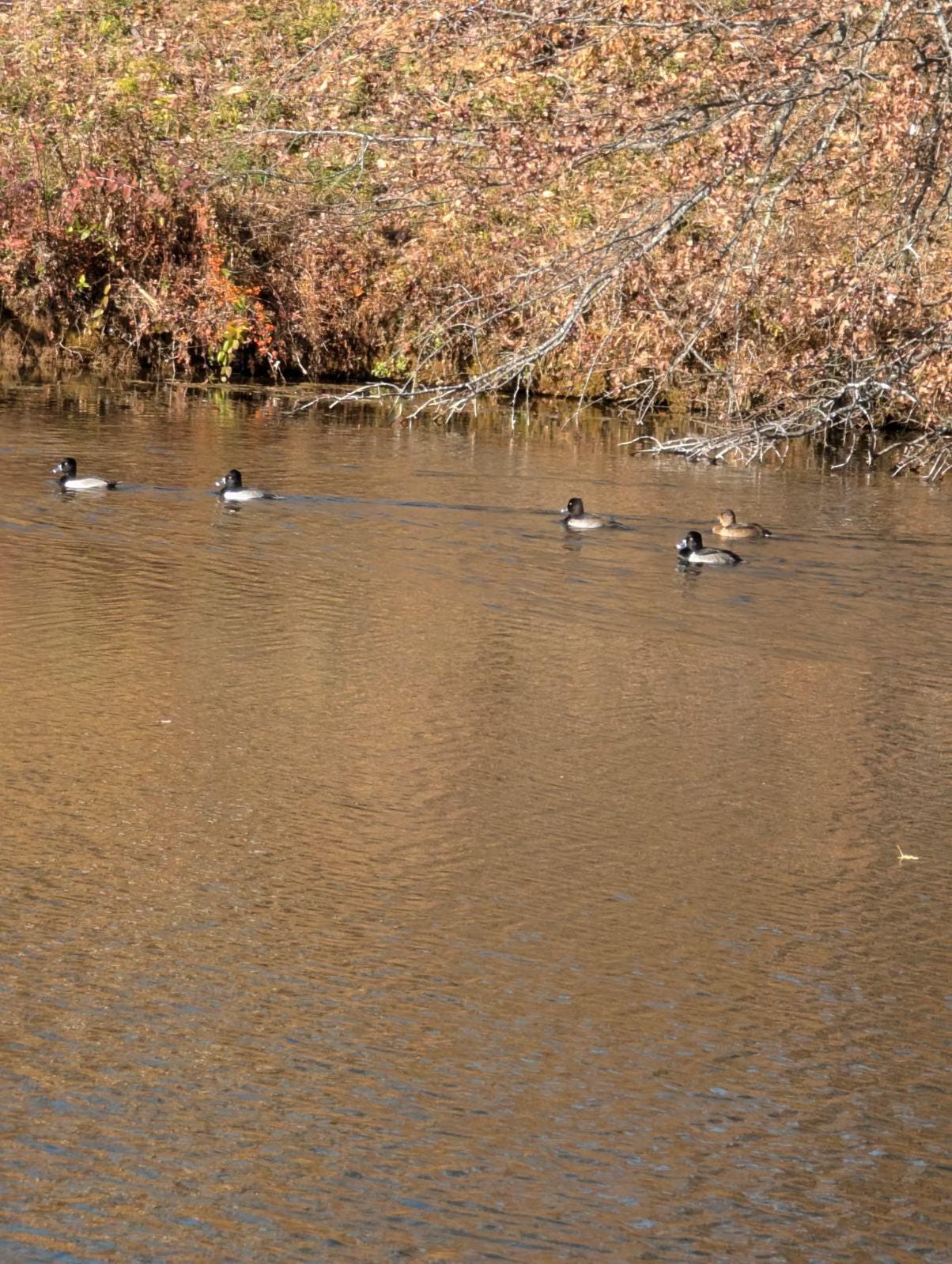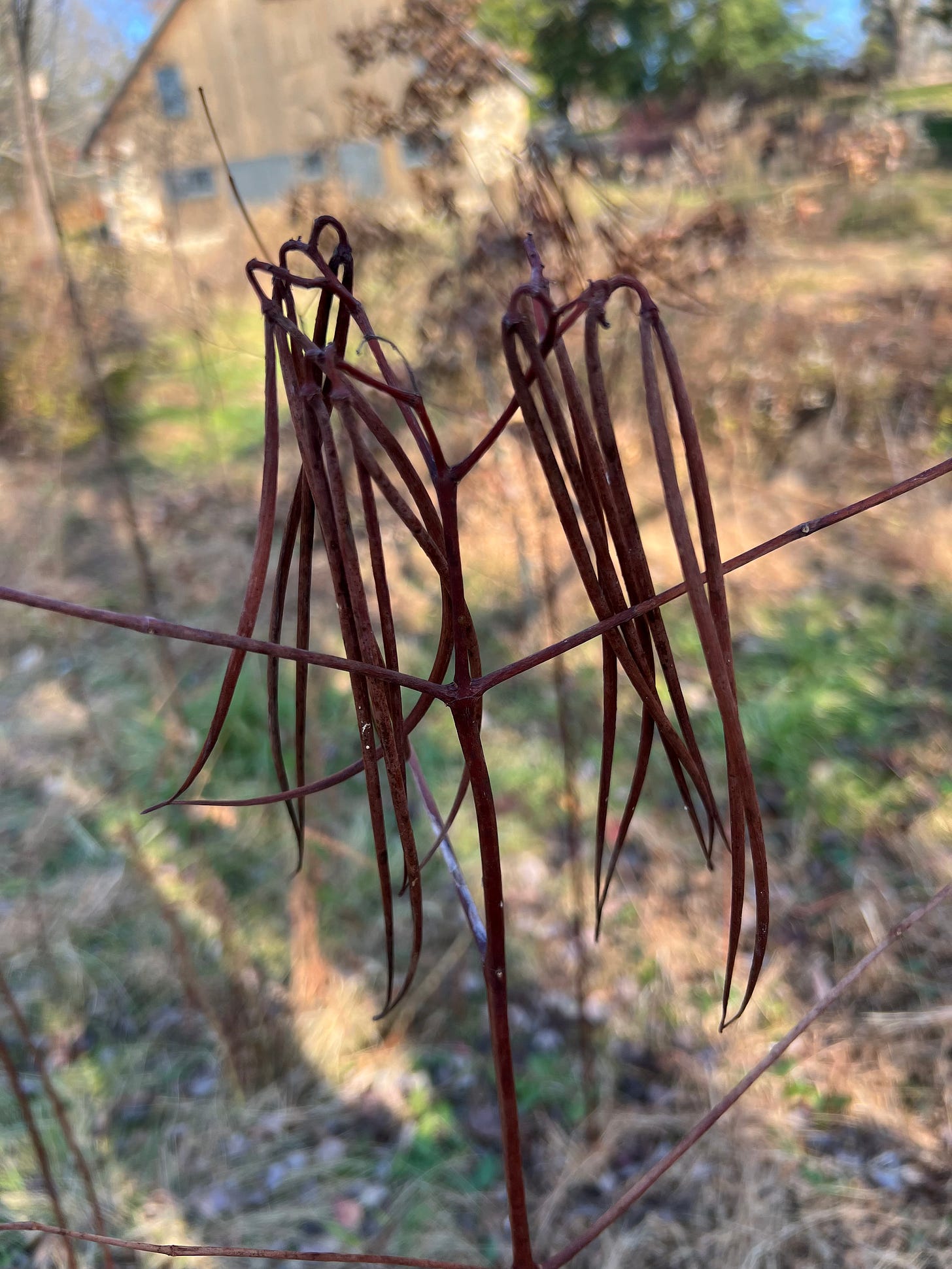Rain. Merciful rain.
After six weeks with little more than a trace, I have never been happier to see water fall from the sky.
Officially, I don’t know whether the Northeast drought is broken. Here at Puddock Hill, we received at least an inch in three days, added to a third of an inch the week before, only traces for six weeks before that. When the first downpour came, as we lay in bed, the sound of rain pattering on chimney cap and windowsills rang especially sweet.
My thoughts go to the smallest trees—those we’ve planted or transplanted over the past few years and the saplings that volunteered by the big pond and in the east woods. I’ve been obsessing over their condition for weeks. Only spring will tell me whether they survived the drought.
All water is local. The New Jersey Pine Barrens, less than a hundred miles from my house, has a historic burn regime despite containing rivers and wetlands. Many of the trees and shrubs are adapted to that regime. The pines have serotinous cones that require high heat to release their seeds. Certain shrubs have evolved to quickly renew themselves after fire consumes their above-ground structure. When wildfires hit the Pine Barrens a few weeks ago—and one night we smelled the smoke here—it seemed more natural than the recent drought itself did elsewhere.
While upland plants withered here at Puddock Hill, the spring that feeds the wet woods remarkably continued to flow. It reminded me that the previous owner of the property had observed that area becoming wetter as houses in the development behind us cropped up. The hidden springs under the big pond also must have continued to feed it during the drought, as the water level scarcely dropped and it continued to gently flow over its spillway.
The rill that runs to the small pond on the other side of the property didn’t stop flowing either, the water level in that pond also remaining undiminished.
It’s possible that this water movement is at least partially a result of development around us, rather than mere nature. Last month, Pam and I visited the Las Vegas Wash, which was once an old stream bed that dried as Nevada became more arid. It became a river again when modern water treatment discharge and urban runoff from impervious surfaces consistently replenished it directly and via small tributaries. Now it’s a vibrant wetland that begins within the boundaries of Las Vegas and drains clean water into Lake Mead, a remarkable story of inadvertent ecological renewal.
Humans affect everything around us. To our northeast at Puddock Hill—the small pond side—decades ago a housing development replaced what was once a forest that would have slowed and absorbed precipitation. Due north of us stretched longstanding farm fields, once part of our property, sold off by the previous owner to a developer.
But neither of these facts quite explains the springs that outlasted the drought. While runoff has sometimes been a problem—and we spent a small fortune mitigating it—the water flowing during a drought must come from another source, which I suspect is human wastewater, cleaned and filtered through many layers of soil, clay and rock, popping back out to the surface where the water table is highest.
Whatever the cause, the continued moisture in parts of the wet woods was a blessing for three river birches I planted there this summer, not to mention other plant life in that area and critters living in the big pond. Not twenty yards away, however, things were bone dry.
Until the rain returned.
One of the many consequences of climate change is its effect on the hydrological cycle, which is just a technical term for how water and water vapor circulate in the atmosphere. Nothing can exist without water, and its relative prevalence and chemistry dictate what lives and dies. Recently, data from NASA satellites revealed that “Earth's total fresh water has plummeted to an alarming new low, and it could be a sign that climate change is pushing the world into a dangerous phase of global drying,” according to an article in Live Science. “Since 2015, our planet's lakes, rivers and aquifers have lost 290 cubic miles (1,200 cubic km) of fresh water, the equivalent of emptying Lake Erie two and a half times.”
The article explains: “As climate change causes temperatures to rise around the globe, water evaporates more readily from its surfaces, and the atmosphere gains an ever increasing capacity to absorb it. This means that when downpours do occur, they are more torrential — dumping more rain in faster and more powerful storms that are more likely to run off than to seep into drier and more compact surfaces.”
Bad things can happen to shrinking, warming bodies of water, or those fed by unnatural runoff. The gravest effect is eutrophication. A related study in Nature, Ecology & Evolution reported: “the observed deoxygenation of the Earth’s freshwater and marine ecosystems represents an additional planetary boundary process that is critical to the integrity of Earth’s ecological and social systems, and both regulates and responds to ongoing changes in other planetary boundary processes. Research on the rapid and ongoing deoxygenation of Earth’s aquatic habitats indicates that relevant, critical oxygen thresholds are being approached at rates comparable to other planetary boundary processes” that are also breaking down.
To forestall this eventuality in my own backyard, we’ve taken measures to limit nitrogen and phosphorus runoff by not using fertilizer (with the exception of the raised bed garden) and allowing plants to grow up around the margins of our ponds. We’re also working to cool the water by allowing more trees to shade the surface.
One further consequence of the changing hydrological cycle is an increase in heavy rain events. For every 1˚F of warming, air holds 4% more moisture. “Globally,” according to Climate Central, “the frequency and intensity of heavy rainfall events have increased since the 1950s, largely due to human-caused climate change.” And in the United States “extreme daily rainfall has become more frequent since the 1980s. Hourly rainfall intensity has also increased since 1970 — by 13% on average across 150 U.S. locations…”
So we are seesawing between extreme dry periods and very wet ones. Here in the Northeast, “the amount of precipitation falling on the heaviest 1% of days has increased 60%…from 1958 to 2021.” You don’t have to be a scientist to know that a 60 percent increase is a big deal.
My hope is that our efforts at rewilding the edges of Puddock Hill will mitigate the harms both of drought and heavy rain. Forested areas cast shade that slows the drying out of soil surface below, as well as cooling nearby air and slowing evaporation and transpiration in the understory. They also contribute to healthier soils that retain moisture better than degraded ones. During downpours they slow the flow of surface runoff, limiting erosion and allowing more water to seep into local aquifers.
In support of this approach, yet another study suggested that rewilding has the potential to “enhance flood and drought resilience” and “evidence suggests that rewilding could lead to reduced flood magnitudes.”
In fact, at Puddock Hill we have already found that planting trees reduces the impact of surface flow from neighboring properties. Of course, this only works long term if the trees survive the drought.
I was walking around earlier this week with the owner of our landscaping service. When we arrived at the path above the big pond, a great blue heron took flight. Twenty minutes later, we spooked a pair of bald eagles from the east woods, one still holding his lunch.
In between, we had a chance to admire this flock of ring-necked ducks (Aythya collaris). I turned out to be the worse photographer. Photos courtesy of Erik Castle:
Seed pods hang from a dogbane stalk near the wet woods:





